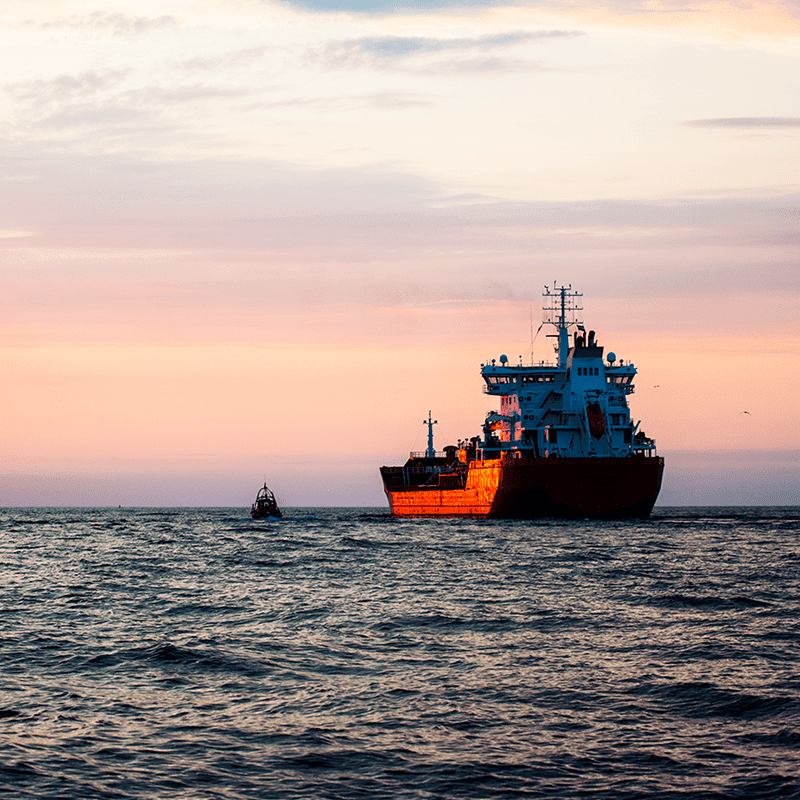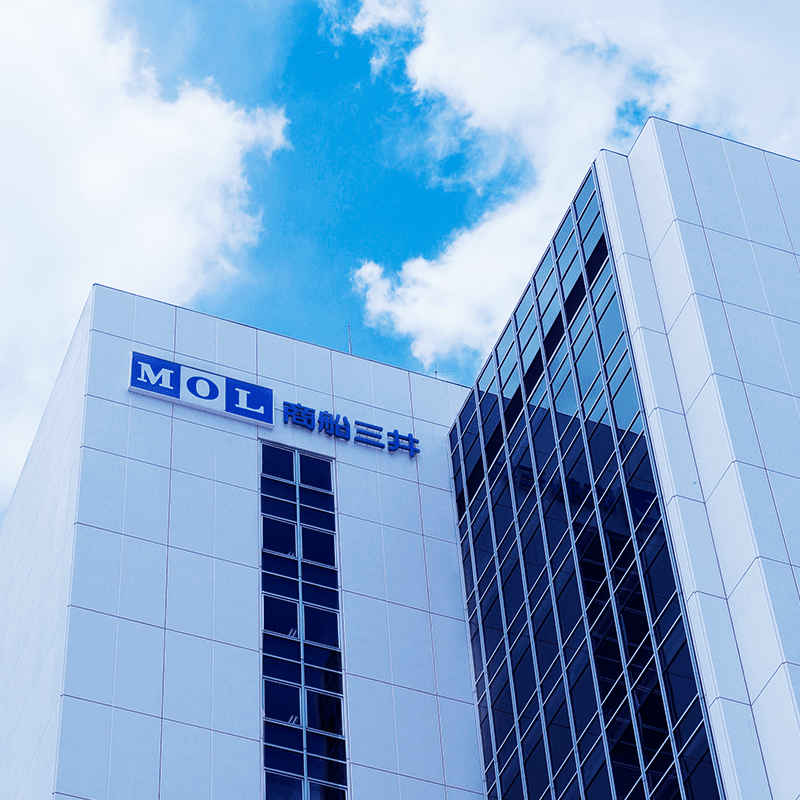BLOG
FSRU & FLNG: MOL’s Gas Value Chain Strategy and Gastech 2025 Highlights
- Energy
- General Shipping
2025.11.20
Key Points
- The Mitsui O.S.K. Lines (MOL) Group is actively strengthening and diversifying its gas value chain, with a focus on Europe and the Americas.
- By leveraging technologies such as FSRU and FLNG, MOL contributes to both energy security and the realization of a low carbon intense society.
- The company flexibly responds to changes energy policy in Europe and the Americas and market trends, advancing new projects with local partners.
- At Gastech 2025 in Milan, MOL Group showcased new LNG carrier designs and the latest technologies, engaging in vibrant networking with industry professionals from around the world.
- Through panel discussions and receptions during the event, MOL contributed to global collaboration and the creation of new business opportunities.
With the stable supply of energy and decarbonization becoming global challenges, the MOL Group is proactively working to strengthen and diversify the gas value chain, particularly in Europe and the Americas. In addition to operating one of the world’s largest fleets of LNG Carrier, the Group leverages technologies such as FSRU (Floating Storage and Regasification Unit) and FLNG (Floating Liquefied Natural Gas) to contribute to regional energy security and the realization of a sustainable society.
The company also aims to create value across the entire value chain by flexibly adapting to changes in European energy policy and market conditions, collaborating with local partners, and promoting new projects.
This article features two main sections: interviews with five key MOL Group members discussing the company’s Atlantic basin gas value chain strategy and future outlook, and an on-site report from Gastech 2025.
Through real voices from the field and the latest initiatives, we introduce MOL Group’s ongoing challenges and growth trajectory.
What is MOL’s Gas Value Chain Strategy in Europe? – An Interview with Five Key Members
Five members of MOL (Europe Africa) Ltd, based in London shared their insights on MOL’s gas value chain strategy, drawing on their respective areas of expertise and on-the-ground experience:
Mr. Suryan Wirya-Simunovic
・Managing Executive Officer, Responsible for Europe and Africa Region, Regional Head of Business in charge of Europe, Africa, and the Americas (Energy Related Business) of Mitsui O.S.K. Lines, Ltd
・Chief Executive Officer of MOL (Europe Africa) Ltd.
Mr. Lou Montilla
・Director, Gas Infrastructure
Mr. Go Sakaguchi
・ Director, Regional Head (Business Administration) Europe Africa
Mr. Bruce Moore
・ Director, New Energy & Decarbonization
Mr. Kohei Iijima
・ Director, Energy Transport
Expanding MOL’s Energy Footprint Across Europe and Africa
First, we asked Mr. Suryan Wirya-Simunovic, CEO of MOL (Europe Africa) Ltd., to provide an overview of the MOL Group’s energy-related businesses in the Europe, Africa, and Americas regions.
———What kind of energy-related businesses is MOL Group developing in Europe and Africa?
Mr. Suryan Wirya-Simunovic
MOL Group is diversifying its energy-related businesses across Europe Africa, and Americas. A key focus is the LNG Gas value chain, where it is advancing projects utilizing FSRUs (Floating Storage and Regasification Units) and FLNGs (Floating Liquefied Natural Gas units). The company also operates LNG carriers (LNGCs) and LNG bunkering vessels and is actively involved in next-generation energy sectors such as CCUS (Carbon Capture, Utilization, and Storage), offshore wind sector and ammonia / hydrogen initiatives. Additionally, MOL contributes to infrastructure development through partnerships and M&A with local ports and logistics companies.
.jpg?width=575&height=376&name=%E6%B8%AF%E6%B9%BE%E5%86%85%E3%82%84%E6%B2%96%E5%90%88%E3%81%A7%E3%81%AE%E3%83%90%E3%83%B3%E3%82%AB%E3%83%AA%E3%83%B3%E3%82%B0%E4%BD%9C%E6%A5%AD%E3%81%8C%E5%8F%AF%E8%83%BD%E3%81%AALNG%E3%83%90%E3%83%B3%E3%82%AB%E3%83%AA%E3%83%B3%E3%82%B0%E8%88%B9%20(1).jpg) An LNG bunkering vessel capable of performing bunkering operations both in port and offshore (Photo: Mitsui O.S.K. Lines)
An LNG bunkering vessel capable of performing bunkering operations both in port and offshore (Photo: Mitsui O.S.K. Lines)
———Why is the gas value chain important in Europe?
Mr. Suryan Wirya-Simunovic
Due to the instability of gas supplies from Russia, Europe needs to diversify its energy sources to ensure energy security. LNG is gaining attention as a relatively stable global diversified energy source. With the EU’s Green Deal and other policies accelerating decarbonization, there is a growing need for transitional energy strategies that incorporate gas alongside renewable energy. As such, developing the gas value chain is critical for Europe.
%E3%81%A8Lou%20Montilla%E6%B0%8F(%E5%8F%B3)%E3%81%AE%E3%82%A4%E3%83%B3%E3%82%BF%E3%83%93%E3%83%A5%E3%83%BC%E3%81%AE%E6%A7%98%E5%AD%90.jpg?width=447&height=339&name=%E3%83%AD%E3%83%B3%E3%83%89%E3%83%B3%E3%82%AA%E3%83%95%E3%82%A3%E3%82%B9%E3%81%AB%E3%81%A6Suryan%20Wirya-Simunovic%E6%B0%8F(%E5%B7%A6)%E3%81%A8Lou%20Montilla%E6%B0%8F(%E5%8F%B3)%E3%81%AE%E3%82%A4%E3%83%B3%E3%82%BF%E3%83%93%E3%83%A5%E3%83%BC%E3%81%AE%E6%A7%98%E5%AD%90.jpg) Interview with Mr. Suryan Wirya-Simunovic and Mr. Lou Montilla at the London office (on-site photo)
Interview with Mr. Suryan Wirya-Simunovic and Mr. Lou Montilla at the London office (on-site photo)
Core Business Focus – FSRU, FLNG, and LNG Transportation
Mr. Lou Montilla provided an explanation of the features of FSRUs (Floating Storage and Regasification Units) and highlighted MOL’s strengths in this field. This interview delves into specific initiatives, including expertise in converting existing LNG carriers, project development across Europe, Africa, and Latin America, and the operation of FSRUs in Poland.
Mr. Sakaguchi discussed MOL’s approach to FLNG (Floating Liquefied Natural Gas) facilities and the company’s strategic partnership with Delfin Midstream Inc. in the United States. Mr. Iijima offered insights into the strengths of MOL’s world-leading LNG fleet and shared his outlook on LNG demand in Europe.
———What is an FSRU and why is it gaining attention?
Mr. Lou Montilla
An FSRU is a floating facility for LNG storage and regasification. Compared to onshore LNG terminals, FSRUs can be deployed more quickly and flexibly. They are especially valuable in regions facing energy supply shortages. Demand is rising in Europe, Africa, and Latin America, and MOL is actively entering these markets by leveraging its expertise in converting existing LNG carriers into FSRUs.
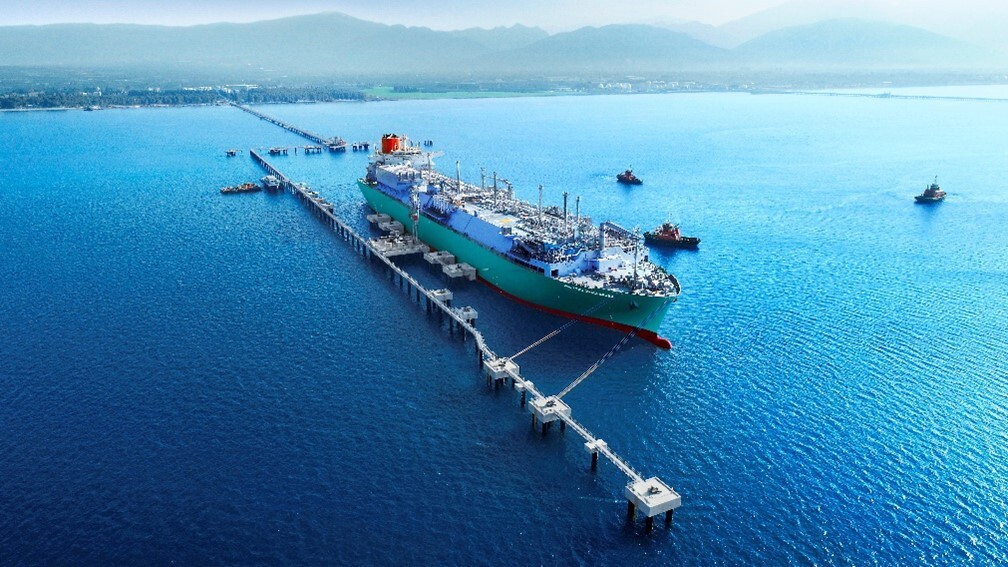
MOL’s FSRU vessel (Photo: Mitsui O.S.K. Lines)
———What are MOL’s strengths in the FSRU business? Can you share specific initiatives in Europe?
Mr. Lou Montilla
MOL’s strengths lie in its ability to offer a tailored solution to the customer. Whether the FSRU solution be a newbuild specification or a converted unit, MOL has the technical and commercial experience required.
For example, MOL is currently executing a newbuild FSRU for a customer in Poland, due to be delivered end 2027. On the other hand, MOL has deployed a converted FSRU to Senegal and Brazil as part of the KARMOL JV*1. The centre of FSRU expertise in the region has been established in London, enabling swift responses to customers in Europe, Africa, and Latin America. MOL also possesses the financial strength and experience to handle complex projects. It should be noted that MOL also has a substantial equity interest in two operational FSRUs based in France and Germany, and provides a ship management service to an FSRU in Turkey.
 KARMOL LNGT POWERSHIP AFRICA deployed in Senegal (Source: MOL Press Release)
KARMOL LNGT POWERSHIP AFRICA deployed in Senegal (Source: MOL Press Release)
(*1)
The LNG-to-Powership project, co-branded as “KARMOL”, is a joint initiative between MOL and Karpower International B.V., a subsidiary of Turkey’s Karadeniz Holdings A.S. The project consists of the collaborative operations of the FSRU to deliver regasified LNG and the Powership to receive regasified LNG in order to produce electricity.
———What is FLNG and what is MOL doing in this area?
Mr. Sakaguchi
FLNG stands for Floating Liquefied Natural Gas and refers to offshore facilities that liquefy natural gas. While liquefaction is typically done onshore, FLNG enables this process at sea, removing hurdles where onshore construction usually faces country like US.
MOL’s FLNG efforts centre on a strategic partnership with Delfin Midstream Inc. (DMI) in the U.S, starting such relationship from 2023. Since MOL’s first investment in DMI, MOL has been supporting DMI to achieve a Final Investment Decision (FID) of DMI’s 1st FLNG vessel, which is on track to achieve within this year.
This is more than a single project investment. Strategically, it represents a key step in our vertical growth strategy in LNG — expanding from shipping, where we are already a global leader, into FSRUs, and now into FLNG production and sales. This vertical integration allows us to capture value along the entire LNG value chain while carefully managing our risk exposure.
.jpg?width=801&height=247&name=%E6%B4%8B%E4%B8%8A%E3%81%A7%E5%A4%A9%E7%84%B6%E3%82%AC%E3%82%B9%E3%82%92%E6%B6%B2%E5%8C%96%E3%81%99%E3%82%8BFLNG%E3%81%AE%E3%82%A4%E3%83%A1%E3%83%BC%E3%82%B8%E5%9B%B3%20(2).jpg) Illustration of an FLNG facility liquefying natural gas offshore (Source: MOL Press Release)
Illustration of an FLNG facility liquefying natural gas offshore (Source: MOL Press Release)
———What are the characteristics and strengths of MOL’s LNG fleet?
Mr. Iijima
MOL’s LNG fleet has been involved in global LNG export projects for over 40 years, and our company has the largest LNG fleet in the world with approximately 140 vessels (as of October 2025). MOL could have the ability to build long-term partnerships with a high level of trust. We are also able to respond flexibly, including contributing to the creation of a value chain that includes conversion to FSRUs or FLNGs. MOL also has strong financing capabilities and a solid reputation in the market, which supports its project development efforts.
———What is the outlook for LNG demand in Europe?
Mr. Iijima
Due to the Russia-Ukraine problem, Europe is accelerating energy diversification, and LNG demand is expected to continue growing. Price stabilization and the push for decarbonization are also driving this trend, especially in the Atlantic region. MOL will respond to this demand by providing supply chain such as upstream (FLNG), midstream (LNG carriers), and downstream (FSRU) value chain services. MOL will also expand LNG carriers equipped with Wind Challenger, a wind propulsion system, to reduce GHG emissions.
 CG rendering of the new ship design featuring four Wind Challenger units (Source: MOL Press Release)
CG rendering of the new ship design featuring four Wind Challenger units (Source: MOL Press Release)
%20Ltd.).jpg?width=705&height=403&name=%E5%B7%A6%E3%81%8B%E3%82%89%E5%9D%82%E5%8F%A3%E6%B0%8F%E3%80%81Bruce%20Moore%E6%B0%8F%E3%80%81%E9%A3%AF%E5%B3%B6%E6%B0%8F(MOL%20(Europe%20Africa)%20Ltd.).jpg)
From left: Mr. Sakaguchi, Mr. Bruce Moore, and Mr. Iijima (on-site photo)
Growth Strategy and Future Outlook Toward a Decarbonized Society
Next, Mr. Suryan Wirya-Simunovic spoke about MOL’s future strategy, which involves ensuring stable operations in the FSRU business, developing and executing new projects, expanding the FLNG business, and further developing the LNG carrier business through integrated efforts.
Mr. Bruce Moore then discussed MOL’s new initiatives aimed at realizing a decarbonized society, including collaborations in renewable energy and CCUS, the development of offshore wind farm support vessels, and the advancement of vessels capable of transporting CO₂.
———What is MOL’s future gas value chain strategy in Europe?
Mr. Suryan Wirya-Simunovic
The strategy includes developing, implementing and then operating FSRU projects with a focus on successfully delivering the Poland and potentially expanding the FSRU project. In FLNG, MOL plans to support construction and operation of Delfin FLNG*2 as a strategic partner of DMI and make further investments into Delfin FLNGs. By integrating these projects, MOL aims to also expand its LNGC business.
(*2)
This is an offshore liquefied natural gas (FLNG) project led by Delfin Midstream Inc. (DMI) in the United States, with MOL (Mitsui O.S.K. Lines) participating as a strategic partner since 2023.
-
———What initiatives is MOL undertaking in decarbonization to enhance the value of its gas value chain strategy?
Mr. Bruce Moore
Beyond the gas value chain, MOL is advancing collaborations with renewable energy and CCUS. Specifically, it is involved in transporting and developing infrastructure for new energy sources such as wind, ammonia, and hydrogen. In Europe, MOL is participating in offshore wind support vessel projects and wind power initiatives at Nigg port*3. It is also developing floating ammonia cracker solutions and dual-cargo vessels*4 capable of transporting CO₂ and other liquefied gases.
(*3)
A port located in Cromarty Firth, in the northeast of Scotland, United Kingdom
(*4)
A vessel capable of transporting multiple types of cargo simultaneously. At MOL, we are developing ships that can carry liquefied CO₂ (LCO₂) together with other cargoes such as methanol, LNG, LPG, and ammonia at the same time.

Joint port business with Mitsui & Co., Ltd. in the UK's Port of Nigg and steel processing and equipment manufacturing business for the energy industry (Source: MOL Press Release)
Gastech 2025 in Milan: Four Days of Navigating the Future!
From here on, we’re excited to share the report on “Gastech 2025,” held in Milan, Italy from September 9 to 12, 2025, with participation primarily led by members of our London office!
Gastech 2025 is the premier global event in the energy sector, co-hosted by industry giants such as Chevron, Eni, ExxonMobil, and Shell. This year, hosted at Fiera Milano, the largest exhibition center in Europe, the event was buzzing with energy, attracting a record-breaking 48,678 attendees from more than 150 different countries. The key sectors highlighted included Natural Gas & LNG, Hydrogen, and Shipping & Marine.
.jpg?width=812&height=279&name=Gastech2025%E3%81%AB%E5%87%BA%E5%B1%95%E3%81%97%E3%81%9F%E5%95%86%E8%88%B9%E4%B8%89%E4%BA%95%E3%81%AE%E3%83%96%E3%83%BC%E3%82%B9_%E3%82%A6%E3%82%A3%E3%83%B3%E3%83%89%E3%83%81%E3%83%A3%E3%83%AC%E3%83%B3%E3%82%B8%E3%83%A3%E3%83%BC%E6%A8%A1%E5%9E%8B%20(1).jpg) Left: MOL’s Booth at Gastech 2025 / Right: Model of a New Designed LNG Carrier Equipped with Four Wind Challenger Units
Left: MOL’s Booth at Gastech 2025 / Right: Model of a New Designed LNG Carrier Equipped with Four Wind Challenger Units
Under the slogan “Navigating Tomorrow: Responsible, Resilient, Revolutionary,” 37 members from across the MOL Group took part in the event. Our booth featured a new design LNG carrier (LNGC) equipped with four Wind Challengers, which drew the attention of many visitors and encouraged them to stop by and engage with our team.
This Wind Challenger-equipped LNGC marked a major milestone in our technical development. During the event, we held two AiP (Approval in Principle) ceremonies to celebrate its progress. We also hosted an AiP ceremony for the Floating Ammonia Cracker, which represented another significant step forward for us.
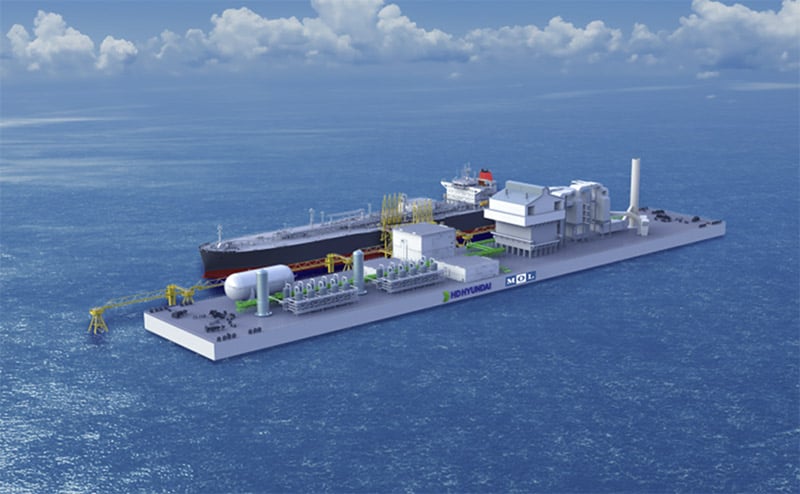
Conceptual design image of Floating Ammonia Cracker(Source: MOL Press Release)
.jpg?width=512&height=384&name=%E5%95%86%E8%88%B9%E4%B8%89%E4%BA%95%E3%83%96%E3%83%BC%E3%82%B9%E3%81%AB%E3%81%A6%E3%83%AC%E3%82%BB%E3%83%97%E3%82%B7%E3%83%A7%E3%83%B3%E3%82%92%E9%96%8B%E5%82%AC%20(1).jpg)
On the evening of September 10, we welcomed guests to the MOL Reception at our booth. The event began with a speech by Mr. Suryan Wirya-Simunovic and featured Japanese sake and light refreshments, which were well received. The reception created a lively atmosphere and successfully fostered networking and strengthened relationships with our partners in the LNG industry.
MOL members actively took part in several key conference sessions. On September 10, Mr. Suryan Wirya-Simunovic joined an invitation-only leadership roundtable to discuss “A New Supply Era for LNG.” On the same day, Mr. Bruce Moore participated in a panel discussion on “Decarbonizing the Maritime Sector.” The following day, September 11, another MOL member presented the Floating Ammonia Cracker project and joined a related panel discussion.
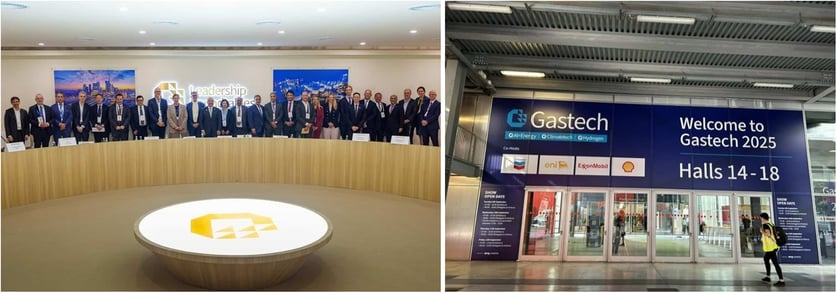
Throughout the four-day event, the MOL Group held meetings with over 90 companies, making it a valuable opportunity to deepen industry connections.
The next Gastech will take place in Bangkok from September 15 to 18, 2026. We look forward to building on the experience gained in Milan as we continue navigating the future of shipping and energy!
Recommended Articles
2022.07.05
- General Shipping
2021.04.13
- Energy
2023.12.19
- General Shipping
2021.08.07
- Eco Friendly
2024.02.06
- General Shipping
- Market Analysis
Latest Articles
2025.11.20
- Energy
- General Shipping
2025.11.11
- General Shipping
2025.10.28
- Energy
- Eco Friendly
- General Shipping

